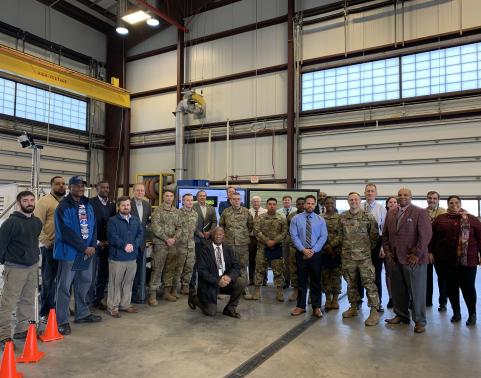Weigh in Motion components prove to be a winner with AMIS

FORT LEE, Va. – The Transportation Coordinators’ Automated Information for Movements System II (TC-AIMS II) is the premiere Army logistics software used for the management of transportation operations. PEO EIS’s Automated Movement and Identification Solutions (AMIS) team continues to improve this application with each new version release. Recently, the AMIS team conducted a proof of concept event for TC-AIMS II to demonstrate the Deployable Automated Cargo Measurement System (DACMS) application, more commonly referred to as Weigh in Motion (WiM).
The WiM proof of concept demonstrated how actual data for execution of all types of unit movements and movement control elements could be coordinated for transportation requests in both CONUS and OCONUS locations. Most importantly, the WiM definitively measures and records actual vehicular weights and dimensional data in relatively fast drive-thru modalities and then simultaneously posts that data in near real-time to TC-AIMS II.
The process is executed through laser-enabled, high-speed reading posts and digital floor-pad sensors, which can fully recognize and record a vehicle's accurate length, width, height, weight, number of axles, and center of balance in real-time—and without the vehicle operator having to come to a complete halt. This capability allows these comprehensive dimensional data profiles of individual vehicles to electronically sync to the corresponding Unit Deployment List records within the TC-AIMS II Unit Move Module.
The current manual entry process often results in human error, time delays and other technical issues. It also can take five minutes or longer to manually update one piece of equipment, and—when considering the time frame needed for entire fleet recognition—the problems become exponentially larger and more complex.
WiM automatically and instantaneously updates vehicular data into the Unit Move module, thereby substantially reducing the time required to input actual dimensions into TC-AIMS II. Most importantly, WiM produces highly accurate dimensional data for additional documentation, such as the transportation control movement documents and Military shipping labels. It also provides accurate dimensional data to key interface partners, such as the cargo movement operations system, the integrated booking system and the global air transportation execution system.
AMIS hosted the proof of concept demonstration of the DACMS to TC-AIMS II from March 5-6, 2020, at Fort Lee, Virginia, with the WiM vendor and the two WiM software developers. Also attending the event were representatives from the U.S. Army Transportation School, Deployment Process Modernization Office (DPMO) and Combined Arms Support Command (CASCOM), including the Army Chief of Transportation, Brig. Gen. Jered P. Helwig. The event provided solid evidence that TC-AIMS II can share an executed movement plan with WiM and, in return, receive an update of accurate dimensional data instantaneously and with virtually no errors. In summary remarks, a DPMO attendee said, “The demonstration proved the [proof of] concept will work, and…we should continue collaborative efforts with AMIS and [its] support contractors to permanently establish the DACMS to TC-AIMS II interface.”
WiM is still considered a pilot program, but the proof of concept demonstration provided agreement about its core value and to its now being further improved to work with the TC-AIMS II interface. To do this, AMIS will work with CASCOM and continue to refine WiM capability requirements. All such improvements might also then become available for inclusion in future releases. The DACMS/WiM to TC-AIMS II interface would ultimately provide new and valuable efficiencies to the Soldier. This innovative process yields order of magnitude benefits, including reduction in time required for inputting dimensional data into TC-AIMS II, increased data accuracy for vehicle documentation, and exact dimensional data of vehicles transmitted in near real-time to interface partners to ensure accurate booking and load planning requirements.
In post-event remarks by Keith Baylor, product lead for AMIS, the event was judged a great success. “This proves for us, the WiM methodology is a winner—not just for AMIS, but for our partners and Army overall,” he said.
AMIS—a program operated by PEO EIS’s Army Data and Analytics Platforms (ARDAP) —provides automated in-transit visibility support and transportation support solutions worldwide.
Related News
-
Coming Soon: GCSS-Army DISCOPS
October 9, 2024Modernized defense business systems are critical to readiness and lethality. Soldiers on the front lines need reliable, continually accessible and user-friendly web-based information and logistics systems that help them perform critical logistics functions. -
Improving Army operations with Integrated Business Planning Demand Planning
May 29, 2024In a strategic move aimed at enhancing Army demand planning and forecasting capabilities, in March 2024, the Logistics Modernization Program successfully implemented Integrated Business Planning (IBP) Demand Planning, replacing the existing Supply Chain Management Demand Planning system. -
GCSS-Army software testing: a look back at the Agile way ahead
March 13, 2024Well before the Army’s ongoing transition to Agile software development, U.S. Army Program Executive Office Enterprise Information Systems’ (PEO EIS) Global Combat Support System – Army (GCSS-Army) product office saw a need to shorten the software testing timeline.
Work for Us
Join a winning team! Search for job opportunities with PEO Enterprise.
Work with Us
Help support important missions. Explore ways your company can work with PEO Enterprise.